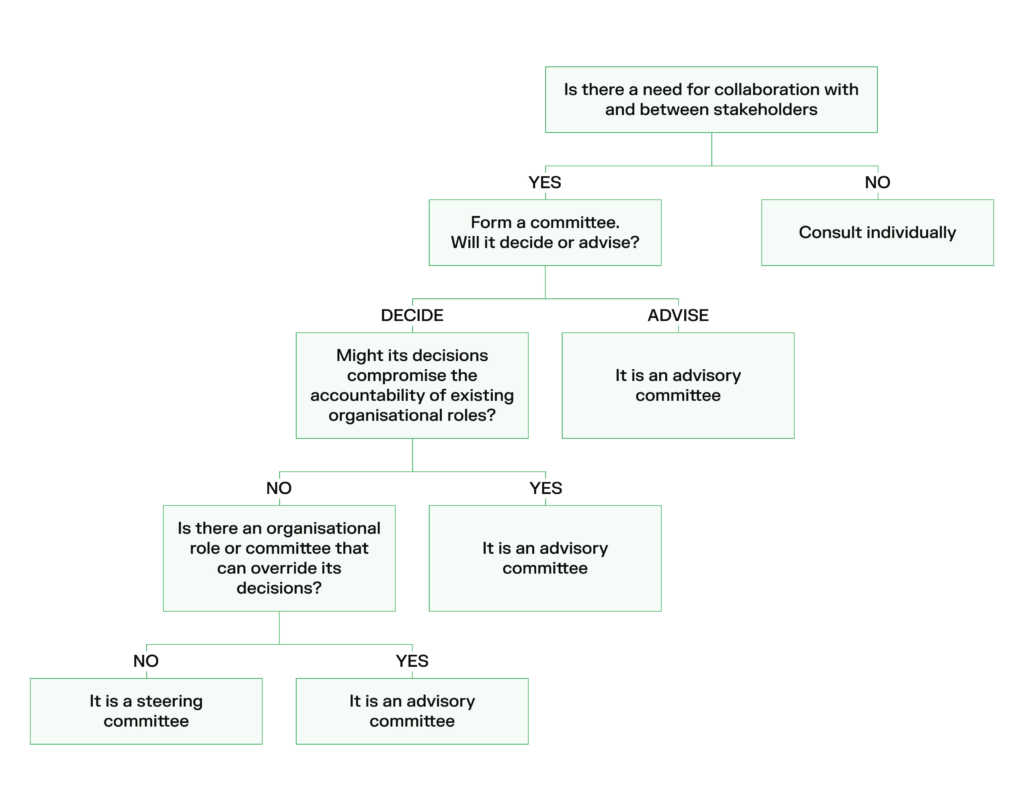Steering committees, when structured and managed properly, can be highly effective and add significant value to project management. But this isn’t always the case.
Ask most project managers and they will tell you steering committee ineffectiveness is often their biggest project challenge. Research identifies it as a significant contributor to project failure.
Vince Marsh
President of Deloitte Canada
What is a steering committee? What does a steering committee do? And how to create an effective steering committee? The article answers these questions and explores the committee’s specific role in M&A deals.
What is a steering committee?
A steering committee is a group of key stakeholders, both from within the organization and external experts or advisors, who provide guidance and support for an organization’s major projects or decisions, such as mergers and acquisitions, strategic partnerships, product launches, and initial public offerings (IPOs).
A steering committee focuses on setting priorities, giving advice, and making sure things are moving in the right direction. Think of it as a team that oversees a project from a higher level, offering leadership and recommendations to ensure success.
Unlike a formal board, a steering committee is more flexible and operates in a way that suits the specific needs of the company or project. Their role is to provide strategic direction without getting deeply involved in the day-to-day details.
So, what is the purpose of a steering committee? In short, it’s to keep the project aligned with its goals, make decisions, and offer guidance to manage risks, resources, and timelines effectively.
There are several types of steering committees, including:
- Project committee
Oversees a specific project, ensuring it stays on track with goals, budget, and timeline.
- Executive committee
Composed of senior leaders, this committee provides strategic oversight for major initiatives like M&A or corporate restructuring.
- Change management committee
Guides organizational change efforts, ensuring effective implementation and adaptation.
- IT steering committee
Focuses on overseeing technology projects, ensuring alignment with business objectives and monitoring progress.
- Compensation committee
Designs pay structures and benefits packages, with board members bringing expertise in business administration to ensure alignment with company goals.
Steering committees in M&A deals
How does a steering committee work during M&A transactions and company buyouts? In short, it oversees critical aspects of the deal, such as due diligence, valuation, and integration planning, ensuring the transaction aligns with the company’s strategic goals and delivers value.
Committee members are responsible for approving key decisions such as due diligence findings, deal structure, and negotiation strategies, while mitigating risks related to finance, legal, and regulatory compliance.
The committee plays a crucial role in integrating cross-functional expertise, bringing together leaders from finance, legal, operations, and compliance to ensure a well-rounded approach to complex issues. They also monitor resource allocation, ensuring teams have the necessary support to drive the transaction forward efficiently.
Additionally, steering committees track deal progress, resolve critical obstacles, and make swift decisions to keep the process on track By coordinating with external advisors, such as investment bankers, legal counsel, and auditors, they ensure the transaction is executed smoothly and in line with the company’s strategic goals, maximizing value and minimizing potential risks.
Responsibilities of a steering committee
Many executives serving on steering committees often struggle with unclear roles and a lack of understanding of how they can contribute effectively to a project’s success. While some may feel confident in their task, only a small percentage truly grasp the full extent of their governance responsibilities.
Let’s focus on the most critical steering committee responsibilities and look at examples of how they work in practice:
- Ensuring alignment with organizational goals
Example: If your company is focused on expanding into new markets, make sure the project supports that goal. If the project no longer serves the company’s broader strategy, the committee should reconsider it.
- Setting clear goals and measurable outcomes
Example: For a software development project, set specific milestones like “Complete Beta testing by X date” and track progress against these dates. Ensure that every goal has a way to measure its success.
- Approving changes to scope, budget, or timeline
Example: If the project team requests additional funding or more time to meet deliverables, the steering committee must first assess the impact on overall project success before deciding whether to approve these changes.
- Identifying risks and implementing mitigation strategies
Example: If there’s a risk of delay because a key supplier is behind schedule, the committee should step in to find alternatives or allocate more resources to mitigate the delay.
- Monitoring project progress
Example: Review regular status updates to ensure the project is on track, focusing on critical areas such as meeting deadlines, staying within budget, and achieving milestones.
Structure and members of a steering committee
The structure of a steering committee varies based on the organization’s size, goals, and the specific project it is overseeing. However, typical steering committee members are:
| Committee members | Role examples | Responsibilities |
|---|---|---|
| Executives and senior managers |
| Provide overall strategic direction and high-level decision-making. |
| Board members |
| Lead the committee, set agendas, facilitate discussions, and guide decision-making. |
| Senior stakeholders and project managers |
| Oversee the day-to-day operations, report progress, and manage resources. |
| Subject matter experts |
| Offer expertise and guidance on specific areas of the project. |
| External experts/consultants |
| Provide specialized advice or insights on certain aspects of the project. |
According to Deloitte, the optimal number of members for steering committees is usually five to 10.
Do you really need another committee?
The question of whether companies truly need steering committees is a matter of ongoing debate. Some argue that these committees often complicate decision-making processes instead of facilitating them. Stephen McGrath and Jonathan Whitty, experts in project management, investigated the role of steering committees, exploring key reasons for their ineffectiveness and proposing actionable solutions. Here are their key findings:
- Unclear roles and responsibilities. Over 80% of participants admitted they were confused about their roles, with many unsure whether they were decision-makers or advisors.
- Misaligned authority. Many steering committees lacked true decision-making power, functioning as advisory groups instead.
- Unnecessary committees. In some organizations, committees were established without a clear need, leading to inefficiencies and overlapping responsibilities.
- Misleading terminology. The term “steering committee” implied authority that many committees did not actually possess, causing confusion both within the committee and across the organization.
McGrath and Whitty proposed several solutions to address these challenges:
- Define purpose and scope. Clearly outline the committee’s goals, decision-making authority, and scope of work.
- Establish terms of reference (TORs). Create specific guidelines to ensure all members understand their roles and responsibilities.
- Streamline committees. Avoid forming unnecessary committees and ensure existing ones are focused and aligned with organizational needs.
Here’s the framework they developed to help you determine whether or not a steering committee is necessary for your organization:

Benefits of a steering committee
When steering committees are well-structured, diverse, and aligned with organizational goals, they do have many advantages for organizations. Key benefits include:
- Clear direction
Steering committees define goals, set priorities, and provide a roadmap for success, ensuring everyone is working towards the same objectives.
- Improved decision-making
By bringing together diverse perspectives and expertise, steering committees enable well-rounded and informed decisions.
- Accountability
They track progress, ensuring teams stay on track, meet deadlines, and remain transparent in their actions.
- Optimized resource allocation
Steering committees assess needs and allocate resources wisely, making sure time, money, and talent are used effectively.
- Risk management
This involves identifying potential risks early on and creating strategies to minimize them, ensuring the project progresses smoothly.
- Stakeholder engagement
They provide a platform for key stakeholders to share their views, fostering collaboration and trust.
- Adaptability
Steering committees monitor progress and adjust plans as needed, responding quickly to any changes or challenges that arise.
Format of steering committee meetings
or steering committees to function effectively, there needs to be some structure to their meetings. Record-keeping, agenda-setting, and having clear objectives for each session will help keep matters on track and lay the foundations for measurable progress.
Key elements of a steering committee meeting are:
- Agenda-setting
The agenda for a steering committee meeting should be carefully planned and distributed in advance to ensure that all members are prepared to discuss relevant topics. It typically includes updates on progress, discussion of challenges or issues, decisions that need to be made, and review of milestones or deliverables.
- Progress reviews
The steering committee will review the status of the project, including accomplishments, ongoing tasks, and any delays or obstacles. This involves assessing whether the project is on time, within budget, and meeting business objectives. Key metrics and KPIs (Key Performance Indicators) are often presented to provide an overview of progress.
- Decision-making
Executive steering committee members often make key decisions regarding the direction of the project, resource allocation, or adjustments to the project plan. The committee also works to resolve issues, remove obstacles, and address risks that may arise during the project’s lifecycle.
Here’s what makes a meeting effective:
- Clear objectives
Define the meeting’s purpose and focus on actionable outcomes.
- Preparedness
Ensure participants come ready with necessary data and updates.
- Time management
Stick to the scheduled time frame and prioritize key topics.
- Active participation
Encourage contributions from all members for informed decision-making.
- Clear action items
End the meeting with specific tasks and deadlines.
- Follow-up
Track progress on action items to ensure accountability.
Effective meetings require efficient data management, collaboration, and accountability. Mergers & acquisitions software plays a key role in supporting these aspects, making meetings more productive and outcome-driven.
M&A software helps ensure preparedness by providing real-time access to financial data and reports. It promotes active participation by equipping all members with up-to-date information for informed contributions. Additionally, it aids in follow-up by tracking action items, deadlines, and team progress.
Examples of steering committees in action
Here are some examples of real-world steering committees that showcase how they operate in different industries and contexts.
1. OPEN Alliance SIG Steering Committee
The OPEN Alliance SIG (Special Interest Group) is a collaboration aimed at advancing automotive Ethernet technologies. It unites key automotive companies to create open standards for Ethernet communication in vehicles.
The OPEN Alliance SIG Steering Committee plays a key role in developing and promoting automotive Ethernet technologies. Composed of representatives from major automotive companies like BMW, General Motors, Toyota, and Volkswagen, the committee sets strategic goals and encourages collaboration across the industry.
In addition to overseeing the organization’s strategy, the committee manages daily operations and communication. Leadership roles, such as Chair, Secretary, Communications Manager, and Web storage Administrator, are rotated regularly to bring new perspectives.
2. The Open Compute Project Steering Committee
The Open Compute Project (OCP) is focused on creating open-source hardware designs for data centers and other technology infrastructures. It brings together engineers and organizations worldwide to collaborate on efficient, scalable, and cost-effective solutions.
The OCP Steering Committee works with the OCP Foundation to review submitted designs, set goals, and drive the project’s growth. They guide the adoption of OCP hardware and foster open collaboration. With their diverse technical expertise, the committee helps shape contribution guidelines, project scope, and strategy.
The committee includes co-chairs and experts in various technical domains such as hardware management, security, networking, storage, and sustainability.
3. OpenQASM Technical Steering Committee
OpenQASM (Quantum Assembly Language) is a standardized framework for describing quantum circuits, enabling interoperability between quantum hardware and software. It supports scalable, hardware-agnostic quantum computing solutions.
The OpenQASM Technical Steering Committee (TSC) oversees the language’s evolution, ensuring alignment with community needs. Composed of six experts from leading organizations (such as IBM Quantum, AWS), the TSC manages contributions, sets goals, and maintains consistency.
Members serve staggered two-year terms, with new members elected by contributors. Meetings are open to all, with decisions made by consensus or majority vote.
Key takeaways
- Steering committees increase value on both the business and project level by providing strategic oversight, managing risks, allocating resources efficiently and fostering collaboration among key stakeholders.
- Key responsibilities of a steering committee include ensuring project alignment with business goals, defining measurable objectives, keeping projects on track, approving changes, managing risks, and resolving conflicts.
- The committee is typically made up of executives, board officers, project managers, subject matter experts, and external consultants, with each bringing specialized knowledge to guide the project.
- In mergers and acquisitions, steering committees provide strategic oversight, approve key decisions, manage risks, ensure alignment with long-term goals, and coordinate with external advisors to drive successful outcomes.




